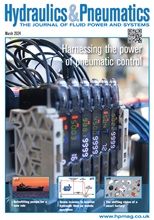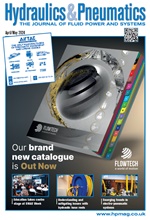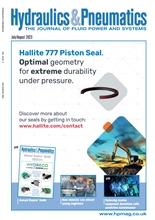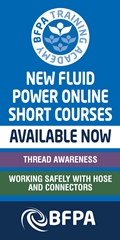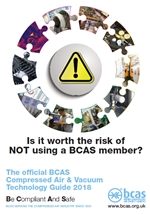- Home » Editorial » Hydraulics
Connection is key to fluid power system efficiency
As equipment and technology advances, it has never been more important that modern fluid power systems perform safely and precisely. However, partnering one manufacturers hose with another’s coupler can seriously jeopardise this. Andrew Dawes, hydraulics product manager at Eriks, explains how to avoid the common pitfalls of specification and why solid connections hold the key to true system efficiency.
It’s common knowledge that high-quality hose assembly is essential to the reliability and efficiency of fluid power systems. The flexibility of hoses enables components to be positioned in the most efficient or convenient place, due to the ability to bend around corners, through tight spaces, or across long distances. Yet, there is a misconception within industry that specifying high quality hoses and end connectors (couplings) from separate manufacturers won’t have any effect on a systems performance. This couldn’t be further from the truth.
Beware of the ‘mix and match’ approach
The amount and type of machinery being imported into the UK has grown dramatically, which has led to suppliers offering countless styles and types of hydraulic hoses, couplings and fittings. With engineers under constant pressure to solve challenges quickly and avoid machine downtime, a hose may be matched from one manufacturer, with couplings from another. This ‘mix and match’ approach to hose and coupling specification can have serious repercussions ranging from minor leaks and major safety hazards, through to unanticipated downtime and increased maintenance costs.
To determine the correct hydraulic hose and coupler has been selected, it is vital to take a holistic view of the system to ensure maximum efficiency. This should take in to account hose performance characteristics and the demands of the application including meeting temperature requirements and pressure capabilities and crucially the compatibility of system components.
Take size for example, in order to select the proper hose size for replacement, it is important to measure the inside and, if through confined spaces, the outside hose diameters exactly, as well as the length of the hose. The inside diameter of the hose must be sufficient to keep pressure loss to a minimum and avoid damage to the hose as a result of heat generation and excessive turbulence.
Risk of reduced hose life
In fact, the hose must be capable of withstanding the minimum and maximum temperatures of the system application. All hoses are rated with a maximum working temperature ranging from -40degC to +100degC based on the fluid temperature, but exceeding these temperature recommendations, for long periods of time, can reduce hose life by up to 80 per cent.
Needless to say, correct specification at the point of purchase can reap dividends for businesses; ensuring systems are not only safe but also as efficient as they possibly can be. To understand the core requirements of a system, it is essential to understand the needs of the business and the environment in which the system will be working. This means taking into account every factor of the application, including fluid and ambient temperatures, environmental conditions, the type of equipment, working and surge pressures, minimum bend radius, fluid compatibility and expected service life and beyond.
Compatibility
Another key factor to consider is compatibility. It can be all too easy for a system to be specified without properly considering whether the tube compound is compatible with the fluid. A chemical resistance chart is a good tool, enabling the specifying to select a hose, hose tube, couplings, cover and O-rings that are consistent with the demands of the fluids. Failure to do so can lead to permeation, which will in turn result in loss of fluid within the system. Compatibility is also an important consideration on the braids, fittings and components yet, they are often forgotten during the specification process. Yet, systems exposed to aggressive fluids, can result in catastrophic failure and even major health and safety implications.
International thread terminations are available in different formats with BSP, Metric, JIC and SAE among the most frequently used. Knowing the equipment’s country of origin is a great starting point when selecting what thread end is used. It’s important to be aware of these differences and ensure that the system components are compatible and therefore safe for use on site.
Interestingly and unknown amongst much of industry is the testing and validation of the hose and coupling interface under strict testing parameters. Eriks is in fact one of a handful of distributors with the capability to test and validate both its own hose and coupling combinations as well as bespoke solutions for clients; ensuring efficiencies on site are met and more importantly that the safety of employees working in and around these connections can be assured.
Regular inspections
Achieving maximum hose performance and safety requires regular inspections of the hose and components prior to, during and after use. Hoses that have become worn or damaged can present a danger to employees and should be replaced immediately.
While testing and validation is imperative pre-installation, failure to properly maintain hoses can also have serious consequences, such as costly material spills, clean-up, downtime and injury. However, regular scheduled inspections, corrective measures and hose replacements can be far less expensive than replacement or repairs made after a failure.
Weak link
It’s vitally important to be aware of all the factors involved when specifying hose and coupling equipment. Get it wrong and a hose assembly is potentially the weak link in your production process. It can be an entrance point for contamination or leakage and a health and safety risk. Get it right and a high-quality hose assembly will not only maintain a fluid system’s efficiency and reliability, but can play a key role in your plant’s performance.
-
Smart Manufacturing & Engineering Week
05 - 06 June, 2024
NEC, Birmingham -
HILLHEAD 2024
25 June, 2024, 9:00 - 27 June, 2024, 16:00
Hillhead Quarry, Buxton, Derbyshire UK



